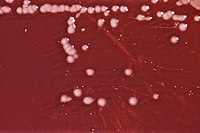
Photo from wikipedia
Introduction. Pseudomonas aeruginosa causes fatal infections in immunocompromised individuals and patients with pulmonary disorders.Gap Statement. Agricultural ecosystems are the vast reservoirs of this dreaded pathogen. However, there are limited attempts… Click to show full abstract
Introduction. Pseudomonas aeruginosa causes fatal infections in immunocompromised individuals and patients with pulmonary disorders.Gap Statement. Agricultural ecosystems are the vast reservoirs of this dreaded pathogen. However, there are limited attempts to analyse the pathogenicity of P. aeruginosa strains associated with edible plants.Aim. This study aims to (i) elucidate the virulence attributes of P. aeruginosa strains isolated from the rhizosphere and endophytic niches of cucumber, tomato, eggplant and chili;and (ii) compare these phenotypes with that of previously characterized clinical isolates.Methodology. Crystal-violet microtitre assay, swarm plate experiment, gravimetric quantification and sheep blood lysis were performed to estimate the biofilm formation, swarming motility, rhamnolipid production and haemolytic activity, respectively, of P. aeruginosa strains. In addition, their pathogenicity was also assessed based on their ability to antagonize plant pathogens (Xanthomonas oryzae, Pythium aphanidermatum, Rhizoctonia solani and Fusarium oxysporum) and kill a select nematode (Caenorhabditis elegans).Results. Nearly 80 % of the plant-associated strains produced rhamnolipid and exhibited at least one type of lytic activity (haemolysis, proteolysis and lipolysis). Almost 50 % of these strains formed significant levels of biofilm and exhibited swarming motility. The agricultural strains showed significantly higher and lower virulence against the bacterial and fungal pathogens, respectively, compared to the clinical strains. In C. elegans, a maximum of 40 and 100% mortality were induced by the agricultural and clinical strains, respectively.Conclusion. This investigation shows that P. aeruginosa in edible plants isolated directly from the farm express virulence and pathogenicity. Furthermore, clinical and agricultural P. aeruginosa strains antagonized the tested fungal phytopathogens, Pythium aphanidermatum, Rhizoctonia solani and Fusarium oxysporum. Thus, we recommend using these fungi as simple eukaryotic model systems to test P. aeruginosa pathogenicity.
Journal Title: Journal of medical microbiology
Year Published: 2022
Link to full text (if available)
Share on Social Media: Sign Up to like & get
recommendations!